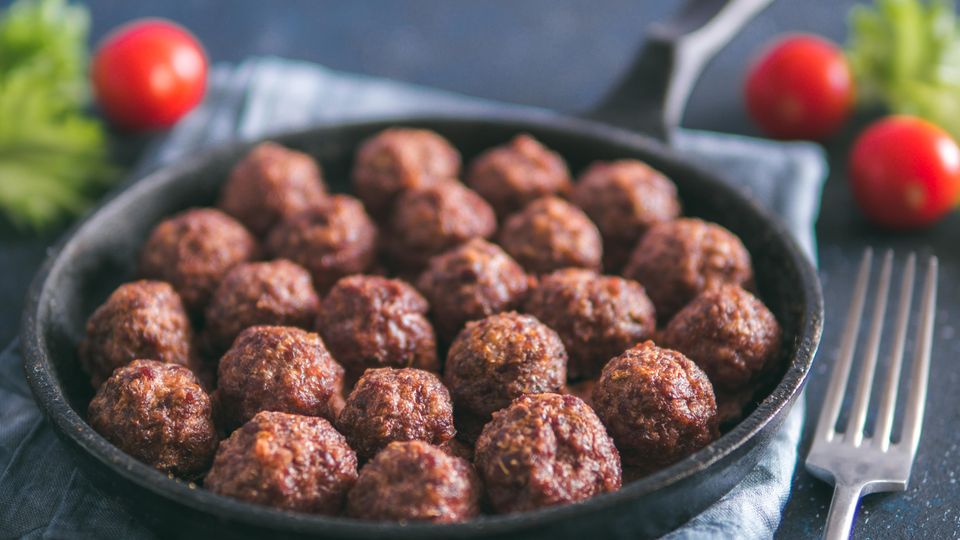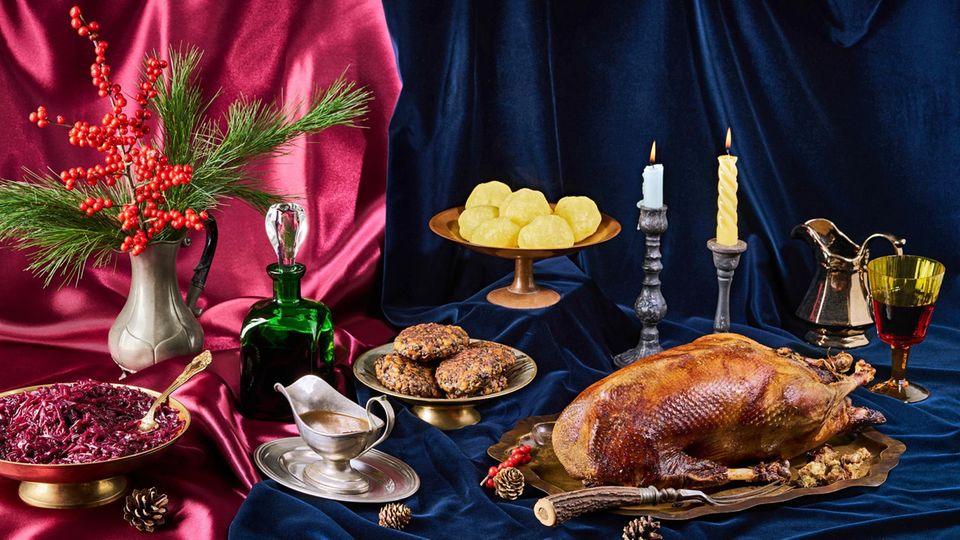TV chef and “The Taste” juror Alexander Herrmann reveals a recipe with which he managed to turn every day into a celebration.
By Sonja Helms
Roasted whole duck is anything but an everyday dish for TV chef Alexander Herrmann, even though he has prepared it so many times. He can still be enthusiastic about them, about their smell, their taste, the interaction of crispy skin and tender, juicy cooked meat. “Just the smell when you open the oven, this sensual moment – that’s unique,” he enthuses. “A roast duck always remains special, also because it’s so rare. Many people don’t dare try it because it takes a lot of sensitivity to get it right – crispy on the outside, cooked and juicy on the inside. When someone serves me a duck , I know: He tried really hard.”
Herrmann has a strong emotional connection to the dish, which is much more than a favorite food. It reminds him of his childhood, of his grandma and her frilly apron, of the whole family that always got together on Sundays. His parents ran an inn and the duck on Sunday was a family tradition. Herrmann lost his parents very early – they died when he was nine years old. Maybe that’s why the duck is a symbol of an ideal world – even if there were always arguments about it.
Best fresh out of the oven
“I still remember how my grandma would always sneak into the kitchen to pick some skin off the duck on either side – where it was particularly crispy,” he says. “It really annoyed my father, but she just wouldn’t stop. When he scolded her, she just waved him off and said: ‘Yeah, those people, they don’t like the skin that much’. Of course not true – on the contrary!”
“Duck is particularly good when it comes straight from the oven and is served immediately,” says Herrmann. Only: Freshly prepared, it takes an hour to be ready. If things have to happen quickly, the bird is cooked after 45 minutes at 220 degrees Celsius, but it takes another quarter of an hour for the order to reach the kitchen and the cook to take the duck out of the cold storage and put it in the roasting pan. “No guest waits that long today,” says Herrmann.
“Even if he did that: I can prepare a single duck like this, but what if I need ten ducks? Then I have a problem as a chef because I don’t have ten ovens,” says Herrmann. So you have to pre-cook the duck, let it sit and then just put it briefly under the grill until it is crispy. “It’s not quite as perfect as it was fresh out of the oven, but it’s still very good.” However, that is difficult to calculate. “Either you have too many ducks or too few ducks. Both are bad. One means disappointing guests, the other is a clear economic loss, because the next day I can no longer sell a fully cooked duck. It no longer tastes good. “
The confit as a brilliant idea
So it happened that Herrmann and his chefs thought about how they could solve this problem permanently. They thought of a classic of French cuisine, confit. Here the meat – usually whole pieces of duck or goose, i.e. breast and legs – is cooked in its own fat, at a low temperature in order to preserve the meat. Because when the fat cools and solidifies, it forms a kind of protective cover against oxygen and bacteria.
Someone had the brilliant idea of preparing the whole duck like a confit. The duck is surrounded by a layer of fat on the outside anyway, so why not? In total, Herrmann and his chefs spent a good three months working on the recipe until it was perfect for their purposes.
Lots of time and patience
The following approach has proven to be ideal: the duck is wrapped tightly in cling film to protect it from drying out. The duck is then gently cooked in the oven at 69 degrees Celsius for eleven hours. “We have found that when meat reaches a core temperature of more than 69 degrees, the protein denatures. Then it starts to become dry. But if you can’t adjust this precisely on the stove at home, 70 degrees will also work,” says Herrmann.
The advantage of this method: After eleven hours at this temperature, the duck breast and the legs are ready at the same time, which is not the case with classic preparation – the legs take longer than the breast. As with confit, the duck meat has a strong duck flavor. “And now comes the interesting thing,” says Herrmann. “The skin is also cooked, but not yet defatted.”
The meat cooked in this way can be preserved like confit – without any loss of taste. You can easily keep it in the fridge for two or three days.
“This is absolute madness!”
To make the duck ready to serve, the foil is removed and it cooks for another 20 minutes in the hot oven – on a rack. The excess fat is squeezed out and the duck becomes evenly brown and crispy on all sides – not just on the top as usual when it is cooked in the roaster and in its own stock. This can also be done at home, as Herrmann emphasizes. “This is a recipe with a guaranteed success.” If you want to serve them to guests, you can easily cook them a day or two in advance. “It’s ready in 20 minutes in the evening and it’s perfect, it’s absolutely amazing!”
It has now been many years since Herrmann and his team developed this method. They still use them today. “For me, every day can be Sunday,” he says, “except that grandma doesn’t pick at the skin anymore.” Today, an ideal world also means: a duck with intact skin.
Whole duck fried until crispy in the oven
For 2 people
Ingredients
- 1 duck (1.2 to 1.4 kg each)
- Salt
preparation
Rinse the duck briefly under cold running water, pat dry with kitchen paper and cut off the rump. Then season with salt inside and out. Now wrap tightly in cling film several times on all sides.
Cook on a baking rack on the middle shelf of the oven at 70 °C for 11 hours. (Commercially available cling film can be safely heated up to 120°C.)
Now take the duck out of the oven, let it cool briefly at room temperature and carefully cut open the foil. Remove the foil from the duck and either process the duck directly or wrap it in fresh cling film and store either in the refrigerator (shelf life 2 to 3 days) or in the freezer (shelf life 3 to 4 weeks).
If the duck is frozen, it must be thawed before further processing. 30 minutes before serving the duck, preheat the oven to 220 °C top and bottom heat and place the duck on a baking rack in the middle of the oven.
Place a baking tray directly underneath. (When the duck is roasted, the fat comes out of the skin. This is collected on the tray and does not burn in the oven.) Important: Pour off the resulting fat from the tray every 10 minutes.
After 25 to 30 minutes, the duck is perfectly crispy and crispy. Remove from the oven, place on a cutting board, let rest for 3 to 4 minutes and then cut off the legs and breast pieces and serve.
TIP:
The whole thing also works with a duck breast if a whole duck is too much. Then it should be a duck double breast on the bone. This piece only needs nine hours in the oven at the same temperature.



